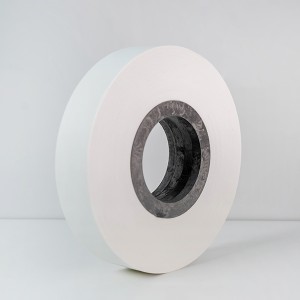
Produk
Benang Aramid
Pengenalan Produk
Benang Aramid mempunyai ciri-ciri yang sangat baik seperti kekuatan ultra-tinggi, modulus tinggi, rintangan suhu tinggi, rintangan asid dan alkali, berat ringan, dan lain-lain. Ia juga mempunyai rintangan kakisan yang tinggi, bukan kekonduksian, dan boleh mengekalkan kestabilan yang wujud pada suhu yang lebih tinggi. Ia adalah bahan pengukuhan bukan logam yang unggul untuk kabel optik.
Penggunaan benang aramid dalam kabel optik mempunyai dua bentuk utama: Pertama ialah menggunakannya secara langsung sebagai unit galas melalui sifat fizikal dan kimia yang unik dan ciri kekuatan tinggi benang aramid. Yang kedua adalah melalui pemprosesan selanjutnya, dan menggabungkan benang aramid dengan resin untuk membuat rod plastik bertetulang aramid (KFRP) yang digunakan dalam struktur kabel optik untuk meningkatkan prestasi aplikasi kabel optik.
Benang Aramid sering digunakan untuk menggantikan dawai keluli sebagai elemen pengukuhan kabel optik. Berbanding dengan dawai keluli, modulus keanjalan benang aramid adalah 2 hingga 3 kali ganda daripada dawai keluli, keliatan adalah dua kali ganda daripada dawai keluli, dan ketumpatan hanya kira-kira 1/5 daripada dawai keluli. Terutama dalam beberapa majlis khas, seperti voltan tinggi dan medan elektrik kuat lain, tiada bahan logam boleh digunakan untuk mencegah pengaliran, dan penggunaan benang aramid boleh menghalang kabel optik daripada terganggu oleh sambaran petir dan medan elektromagnet yang kuat.
Kami boleh menyediakan benang aramid jenis am dan modulus tinggi untuk memenuhi keperluan berbeza kabel optik dalaman/luar.
ciri-ciri
Benang aramid yang kami sediakan mempunyai ciri-ciri berikut:
1) Graviti tentu ringan dan modulus tinggi.
2) Pemanjangan rendah, kekuatan pecah yang tinggi.
3) Rintangan suhu tinggi, tidak larut dan tidak mudah terbakar.
4) Sifat antistatik kekal.
Permohonan
Terutamanya digunakan untuk tetulang bukan logam kabel optik ADSS, kabel optik penampan ketat tertutup dan produk lain.
Parameter Teknikal
| item | Parameter Teknikal | ||||
| Ketumpatan Linear (dtex) | 1580 | 3160 | 3220 | 6440 | 8050 |
| Sisihan ketumpatan linear % | ≤±3.0 | ≤±3.0 | ≤±3.0 | ≤±3.0 | ≤±3.0 |
| Kekuatan pecah (N) | ≥307 | ≥614 | ≥614 | ≥1150 | ≥1400 |
| Pemanjangan pecah % | 2.2~3.2 | 2.2~3.2 | 2.2~3.2 | 2.2~3.2 | 2.2~3.2 |
| Modulus tegangan(GPa) | ≥105 | ≥105 | ≥105 | ≥105 | ≥105 |
| Nota: Lebih banyak spesifikasi, sila hubungi kakitangan jualan kami. | |||||
Pembungkusan
Benang Aramid dibungkus dalam gelendong.

Penyimpanan
1) Produk hendaklah disimpan di dalam gudang yang bersih, kering dan berventilasi.
2) Produk tidak boleh disusun bersama dengan produk mudah terbakar atau agen pengoksidaan yang kuat dan tidak boleh berdekatan dengan sumber api.
3) Produk harus mengelakkan cahaya matahari langsung dan hujan.
4) Produk hendaklah dibungkus sepenuhnya untuk mengelakkan kelembapan dan pencemaran.
5) Produk hendaklah dilindungi daripada tekanan berat dan kerosakan mekanikal lain semasa penyimpanan.
Maklum balas





SYARAT CONTOH PERCUMA
ONE WORLD Komited Untuk Menyediakan Pelanggan Dengan Wayar Berkualiti Tinggi Dan Matenas Kabel Dan Perkhidmatan Kelas Pertama
Anda Boleh Meminta Sampel Percuma Produk Yang Anda Berminat Bermakna Anda Bersedia Menggunakan Produk Kami Untuk Pengeluaran
Kami Hanya Menggunakan Data Percubaan Yang Anda Bersedia Untuk Maklum Balas Dan Kongsi Sebagai Pengesahan Ciri Dan Kualiti Produk, Dan Kemudian Bantu Kami Untuk Mewujudkan Sistem Kawalan Kualiti Yang Lebih Lengkap Untuk Meningkatkan Kepercayaan Pelanggan Dan Niat Membeli, Jadi Sila Yakinkan Diri
Anda Boleh Mengisi Borang Di Sebelah Kanan Untuk Meminta Sampel Percuma
Arahan Permohonan
1 . Pelanggan Mempunyai Akaun Penghantaran Ekspres Antarabangsa Atau Membayar Pengangkutan Secara Sukarela (Kargo Boleh Dipulangkan Mengikut Pesanan)
2 . Institusi yang sama hanya boleh memohon untuk satu sampel percuma produk yang sama, dan institusi yang sama boleh memohon sehingga lima sampel produk yang berbeza secara percuma dalam masa satu tahun
3 . Sampel Hanya Untuk Pelanggan Kilang Kawat Dan Kabel, Dan Hanya Untuk Kakitangan Makmal Untuk Pengujian atau Penyelidikan Pengeluaran
CONTOH PEMBUNGKUSAN
CONTOH PERCUMA BORANG PERMINTAAN
Sila Masukkan Spesifikasi Sampel Yang Diperlukan, Atau Terangkan Secara Ringkas Keperluan Projek, Kami Akan Mengesyorkan Sampel Untuk Anda
Selepas menyerahkan borang , maklumat yang anda isi mungkin dihantar ke latar belakang SATU DUNIA untuk diproses selanjutnya bagi menentukan spesifikasi produk dan maklumat alamat dengan anda. Dan juga boleh menghubungi anda melalui telefon. Sila baca kamiDasar PrivasiUntuk butiran lanjut.











